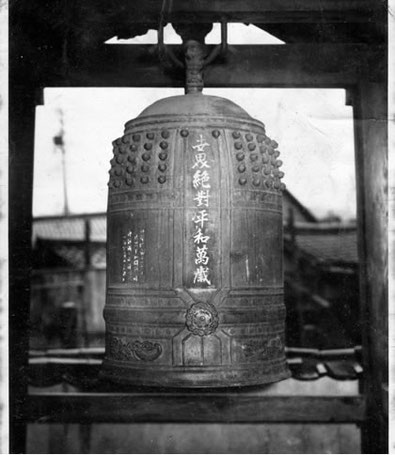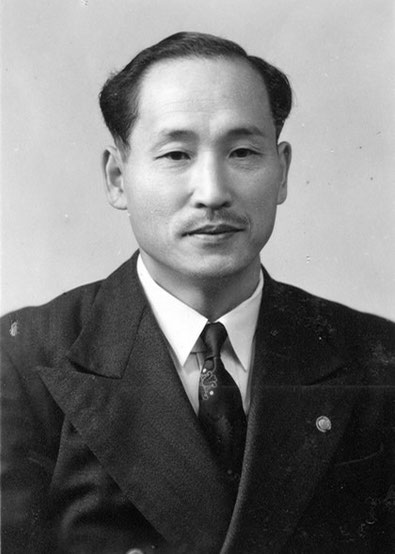Most visitors to the Central Library’s Maguire Gardens see Jud Fine's “Spine” installation and the unique collection of fountains that grace the gardens, but not everyone notices tucked away in the westernmost corner, nearest Flower Street, a quiet token of the most ambitious possibility, the World Peace Bell.
The Japanese style oblong-shaped bell is unlike most bells; it has no clapper. Instead, it is rung by hitting a wooden dowel or hammer against its outside. The bell itself is significant because of its material: melted down medals and metal coins from more than 100 countries.
The history of the peace bell began in 1947 in Japan at a commemoration of the second anniversary of the dropping of the atomic bomb on Hiroshima, which took place around a wooden peace tower built for that occasion.
That first bell was created by Chiyoji Nakagawa, whose traumatic experiences as a Japanese soldier during World War II led him to commit to peace for his life. Nakagawa was shot while on a Burmese battlefield and lost consciousness. When he awoke, he found himself alone, and in a pagoda (bell tower.) His entire brigade had been lost.
His first efforts led to the replacement of the bell in his family temple, the Taihei Temple in Uwajima City, in the southwest part of Shikoku Island. That bell was cast from coins from 26 countries plus Nakagawa’s military sword from the Burmese battlefields. The bell is decorated with a laurel leaf, an historic international symbol of peace, and eight Kanji letters on the surface that translate to "Absolutely Peaceful World, Cheers.” A replica was later presented to the Japanese emperor on his visit to Uwajima City.

The First Peace Bell, built in Japan in 1951, contained metal coins from 26 countries and the metal sword Nakagawa used on the battlefields of Burma during WWII. He was the only survivor of his regiment.
In pursuit of his mission for world peace, Nakagawa traveled to the 6th UN General Assembly in Paris in 1951 where Japan submitted its first application to join the United Nations. As an executive member of the United Nations Association of Japan and observer, Mr. Nakagawa proposed building a bell at the UN as a symbol of peace.
At that assembly, Nakagawa made a presentation which included his recording of the Japanese world peace bell ringing. He was able to collect coins from 65 countries and was also given nine gold coins from Pope Pius XII in support of his mission of peace.
The coins Nakagawa received in Paris were joined by coins given by many from Japanese citizens who heard of Nakagawa’s efforts. They gave him old and current coins, sword guards, bullets, copper badges, religious badges, and copper sheets from shrines for a total of 112.5 kilograms.
These were all used in the creation of the Japanese Peace Bell, 100 cm high and 60 cm in diameter. It was cast at the Tada Foundry, Takamatsu City, Ehime Prefectureas, with Jonosuke Tada the director of the project. It hangs from a classic tower created by Rinpei Ooshita, a carpenter specializing in temple and shrine architecture.
The bell was shipped from Yokohama Port in December 1953 to UN Headquarters, New York and donated in the name of the Japan UN Association. It was formally presented to the UN on June 8, 1954 with Renzo Sawada, UN Ambassador and Benjamin Cohen, UN Deputy Director-General, in attendance. Despite his many efforts, Nakagawa was unable to attend; his name is nowhere to be found on the bell or bell tower.
Soil from both Hiroshima and Nagasaki were used in the bell site at the UN. Contributing the soil were a Zen priest at the Ryokan Zen temple in Uwajima City, who was injured by the nuclear bomb in Hiroshima, and a Christian schoolgirl from Nagasaki. Because the soil could not be cast with the metal in the bell, it is buried under the Peace Bell's foundation stone to reflect the aspiration for peace by hibakusha. (Hibakusha is a newly-created Japanese word to imply bomb-affected people, primarily those from Nagasaki or Hiroshima.)
The bell remains on display in the West Court Garden in front of the United Nations headquarters known as the Secretariat Building. The Secretary General rings the bell every year at the opening of the General Assembly as a prayer for world peace. The bell is also rung on the vernal equinox day (March 20) and on September 21, the International Day of Peace, an event of the United Nations first declared in 2001.
During the next decade, which brought the Berlin crisis of 1961, sister bells were cast and presented to both US President J.F. Kennedy and then-USSR Prime Minister Nikita Krushchev through their ambassadors in Tokyo, as an appeal for peace. The UN World Peace Bell was temporarily returned to Japan in 1969 for its World Expo in Osaka, and a temporary one was installed in New York. Smaller replicas of the world peace bell have so far been presented to leaders of 140 countries, including then-UN Secretary-General U Thant, a diplomat from Burma.

Chiyoji Nakagawa, a private citizen, led the efforts to have a world peace bell installed at the UN headquarters in New York. His family carries on his mission today through the Association for the Preservation of the UN Peace Bell.
In 1967, Nakagawa wrote, “As the UNESCO Constitution stipulates, let us construct a fort of peace in each individual's mind. Let us also tie souls of individuals, and let us make peace as the motto of mankind. Let us respect human beings thoroughly. Let us wish for a world as one family. I wish to see the spirit of the Peace Bell is proliferated to each family and each individual.”
To acknowledge Nakagawa’s efforts, Japan awarded him its Senior Sixth Rank, Fifth Order of Merit, Order of the Rising Sun. He died in 1972 and his funeral was conducted by the city at the public hall of Uwajima City, a self-declared “city of absolutely peaceful world.”
After Nakagawa’s death, a second organization, The World Peace Bell Association (WPBA), was founded in Japan to honor and continue his lifelong aspirations for peace.
The WPBA presented the bell to the City of Los Angeles and it was placed in Maguire Gardens on January 26, 2001. Then-mayor of Los Angeles, Richard J. Riordan, accepted the bell on behalf of the city.
Fifteen other WPBA bells have been given to cities around the world, including Berlin, Warsaw, Ankara, Ottawa, Mexico City, Brazil City, Buenos Aires, Ulan Bator (Outer Mongolia); Cowra (Australia); Quezon City (Philippines); Quito (Ecuador); Alcobendas (Madrid, Spain); Tashkent (Uzbekistan), and Christchurch (New Zealand). The locations of the five peace bells in Japan are Ishigaki Island, Okinawa; Soya Misaki/Cape Soya, Wakkanai, Hokkaido; Tsurumi Ryokuchi Park, Osaka; Amazaki Motohama Ryokuchi Park, Hyogo, and in Hieizan Enryaku-ji Temple, Mount Hiei, Shiga.
Nakagawa's son Shikataro Nakagawa, chairman of the Association for the Preservation of the UN Peace Bell, has written on its website, “I believe that we need to continue to pursue the world peace, share the story of the Peace Bell and the thoughts of Chiyoji Nakagawa on peace, and spread words that need to be inherited by new generations.” His sister, Seiko Takase, a member of the organization’s board, wrote us that, although the WPBA’s bell in Los Angeles is somewhat different from the original design her father developed more than 60 years ago, “...we share the same aspiration for peace and are honored to see more and more people around the world become aware of the spirit of Chiyoji Nakagawa.”
To further that spirit, Ms.Takase published a children’s bilingual book in Japanese and English, The Story of the UN Peace Bell, with a story by Takase and bilingual text and illustrations by Rutsuko Aizawa. It is distributed by New York Seikatsu Press, Inc.
Please join us for a docent-led tour of the Central Library.
The World Peace Bell was presented for placement in the Maguire Gardens of Central Library in 2001. It was a gift from the World Peace Bell Association to the City of Los Angeles.
Photo by Diana Rosen. All other photos courtesy of the Association for the Preservation of the UN Peace Bell
Blog Post by Diana Rosen
